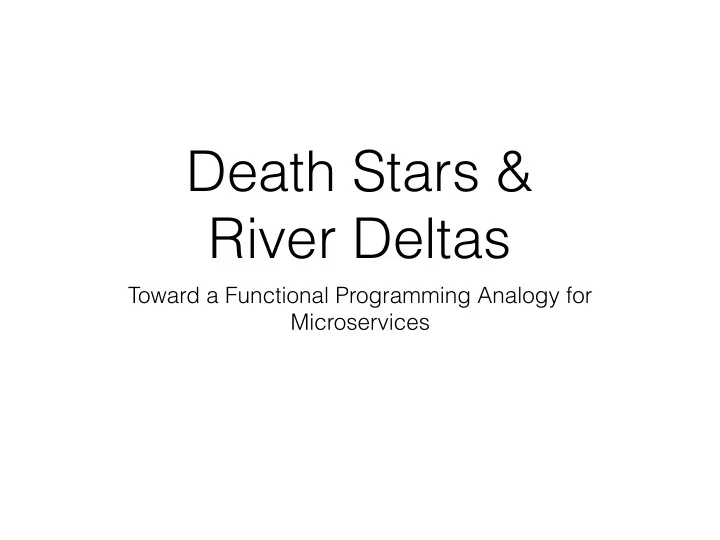

Death Stars & River Deltas Toward a Functional Programming Analogy for Microservices
Hi, I’m Bobby I’m on the Technology Fellows team at I dislike accidental complexity bobby.calderwood@capitalone.com @bobbycalderwood https://github.com/bobby
Disclaimers • What follows is not a rigorous attempt to extend the formal models of OO and FP to the distributed case • Rather, it is an informal extension of basic intuition and principles • Plus I’m intentionally trolling a little, relax :-)
Microservices! • Adopt! • Abandon! • Assumptions…
AWS Death Star diagram, circa 2008 as per Werner Vogels tweet https://twitter.com/Werner/status/741673514567143424
Object-Oriented • Encapsulated data access via synchronous calls • Mutable state change via synchronous calls • Dependency web • Imperative, sequence-oriented orchestration • Referentially opaque
Functional Programming • Data access via ubiquitous access to immutable values • State change via mapping an identity to different immutable values over time • Data Flow graph • Declarative orchestration • Referential transparency
Contrasting Principles Object Oriented Functional Data Access Encapsulated Ubiquitous Immutable, values over State Change Mutable, in-place time Organization Dependency graph Data-flow graph Orchestration Imperative, sequential Declarative, parallelizable Referentially… Opaque Transparent
Object-Oriented • Might be fine within single memory space (let’s talk…) • Does not scale well to distributed case!
Distributed Objects • Latency grows with depth of dependency graph • Temporal liveness coupling • Synchronous, pull-oriented by default • Cascading failure modes • Inconsistent, imperative orchestration • Hidden narrative: can only see the nouns, verbs ephemeral • Complexity: how to reason about state of system at any point in time?
Source: NASA, Public Domain
Deltas and Lambdas • OO : Death Star :: FP : River Delta • Functional Programming analogy scales well to the distributed case!
Distributed Functions • Low latency at both read and write time (with eventual consistency in between) • Temporal de-coupling • Isolated failure modes • (Eventually) consistent, declarative orchestration • Reified narrative: event stream • Clear reasoning about (and replay of!) state over time
Example: Balance Calculation • Customer-defined weekly spending limits/ notifications on a particular account • Aggregate the debits, possibly emit event when balance exceeds limit for time period • React to event in customer-defined way (prevent additional transactions until end of period, send notification, etc.) • Allow customer to see transactions and balances
OO-Analogy µServices
FP-Analogy µServices
But how? • Architecture informed by • Techniques • Rules • Tools
FP-Analogy µServices
Techniques • REST (at the edge) • CQRS • Event Sourcing (storage) • Pub/Sub (conveyance) • Sagas • Serverless
Rules 1. Capture all observations and changes at the edge (carefully!) to an immutable event stream 2. Reactively calculate streams of derived state from the event stream 3. Aggregate state wherever and however it provides value 4. Manage outgoing reactions (“side-effects”) to state and events carefully
Capture changes at the edge to immutable event stream • A (very) few authorized teams capture all raw observations (Events) and customer requests for action (Commands) • at the edge of bounded context • with minimal processing • immutably and durably • Causally related events go on same log • One (logical) writer per command/event stream • No change gets into bounded context via any other means!
Capture changes at the edge to immutable event stream
Reactively calculate derived state from the event log • A few authorized teams process Commands into Events (probably using aggregate state) • A few (more) authorized teams calculate state streams of general interest derived from Events • Single-entity state changes • Regulated or audited calculations • Could be recursive, i.e. certain state changes might trigger further events downstream
Reactively calculate derived state from the event log
Aggregate state wherever and however it provides value • Many teams across orgs aggregate streams into views for their respective use-cases • Into whatever data store makes sense for required data access pattern • Possibly emitting views back onto streams (a la Kafka Streams’ KTable) • Facilitates stateful computations: joins, windowed aggregates, command processing • Everyone traces lineage all the way back to edge Command/ Event
Aggregate state wherever and however it provides value
Manage “side-effects” carefully • A few authorized teams react to Events by reaching outside of bounded context to cause “side-effects” • A “side-effect” in this case is any action not associated with reading or writing the streams or aggregates, e.g. • Sending email, text message • Making a call to an outside web service • Calling a service to write a command/event to a stream you don’t own • Log results of attempt to stream to facilitate retry, Saga/rollback/ compensating action
Tools • Kafka • Kafka Streams • Kafka Connect • Various data stores • Serverless integrations (e.g. OpenWhisk Kafka package)
Example
Questions?
References Sagas: https://www.cs.cornell.edu/andru/cs711/2002fa/reading/ • sagas.pdf Ben Stopford on Events/Microservices: https://www.confluent.io/blog/ • build-services-backbone-events/ Rich Hickey: • Clojure’s approach to state: https://clojure.org/about/state • The Value of Values: https://www.infoq.com/presentations/Value- • Values The Language of the System: https://www.youtube.com/watch? • v=ROor6_NGIWU
Recommend
More recommend